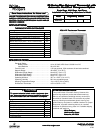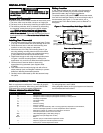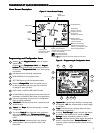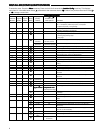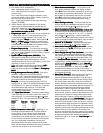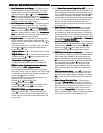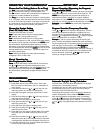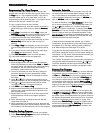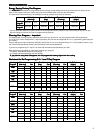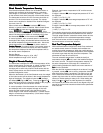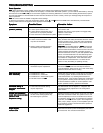
10
PROGRAMMINGPROGRAMMING
PROGRAMMINGPROGRAMMING
PROGRAMMING
WW
WW
W
irir
irir
ir
ed Red R
ed Red R
ed R
emote emote
emote emote
emote
TT
TT
T
emperemper
emperemper
emper
aa
aa
a
turtur
turtur
tur
e Sensinge Sensing
e Sensinge Sensing
e Sensing
One remote temperature sensor can be installed indoor or
outdoor and connected to the thermostat by a maximum
cable length of 100 meters (300 feet). Terminals +, S and -
on the terminal block allow connection of the remote sensor.
The thermostat must have 24 VAC Common connection to
terminal C for the remote sensor to operate. The remote
sensor can be enabled or disabled in the Installer/Configura-
tion menu, item 25.
When remote sensor,
RemoteRemote
RemoteRemote
Remote, is selected
Off Off
Off Off
Off (factory
default), no remote sensor is enabled. When remote sensor
is selected
On, On,
On, On,
On, the next step is to select the remote as
indoor,
Remote InRemote In
Remote InRemote In
Remote In, or outdoor,
Remote OutdoorRemote Outdoor
Remote OutdoorRemote Outdoor
Remote Outdoor. If the
remote is selected as
Remote InRemote In
Remote InRemote In
Remote In, an additional step will be to
select if the temperature shown on the display will be from
the thermostat,
LS OnLS On
LS OnLS On
LS On, or the remote sensor
Ls OffLs Off
Ls OffLs Off
Ls Off.
In normal operation, when a remote sensor is enabled the
time digits of the display will alternate between the time and
the remote temperature for three seconds each. Above the
remote temperature will be
RemoteRemote
RemoteRemote
Remote, for indoor sensor or
Outdoor RemoteOutdoor Remote
Outdoor RemoteOutdoor Remote
Outdoor Remote, for outdoor sensor. If the remote sensor is
an indoor sensor and the local display has been disabled,
the temperature displayed as the room temperature will be
the remote sensor temperature.
Sensing Range:
Outdoor temperature range is -40 to 140
o
F
Indoor temperature range is 32
o
F to 99
o
F
Weight of Remote Reading:Weight of Remote Reading:
Weight of Remote Reading:Weight of Remote Reading:
Weight of Remote Reading:
The thermostat is designed to receive the temperature of the
indoor remote sensor and average, or weight, it with the local
sensor in the thermostat for each program period. The
averaging will be active only when the local sensor and the
indoor remote sensor are both functional and enabled in the
Installer/Configuration menu.
When the thermostat is in the Set Schedule mode, the weight
of the indoor sensor will be shown in the current temperature
digits of the display. The weight will show as
A2A2
A2A2
A2 (average
and default),
H4H4
H4H4
H4 (high) or
L1L1
L1L1
L1 (low). Pressing the and
keys at the same time will change the weight for the program
period. The weight of the local sensor is fixed.
In normal operation of the thermostat, the current tempera-
ture displayed will be the weighted average of the local
sensor and the remote sensor using the formula (local
sensor weight x local sensor temperature) + (remote sensor
weight x remote sensor temperature) / (local sensor weight +
remote sensor weight).
Dual Fuel Temperature SetpointDual Fuel Temperature Setpoint
Dual Fuel Temperature SetpointDual Fuel Temperature Setpoint
Dual Fuel Temperature Setpoint
When the thermostat is configured for Heat Pump mode and
an outside remote sensor is installed, the thermostat can
monitor the outside temperature. When the outside tempera-
ture falls below a user selectable temperature, the thermostat
will switch to gas heat and shut down the compressor. This
eliminates the need for a fossil fuel kit.
The user selectable temperature is called the dual fuel
temperature setpoint,
dF dF
dF dF
dF and is set in the Installer/Configura-
tion menu, item 26. The dual fuel temperature setpoint can
be set to a temperature of 5 through 50. A selection of 5
(default setting) disables this feature and menu selection of
CdCd
CdCd
Cd will not be available.
After the dual fuel temperature setpoint is set above 5 and
is pressed, a delay,
CdCd
CdCd
Cd, can be set for compressor shutdown
after the auxiliary stage is energized. This delay can be set
from 0 seconds to 99 seconds to minimize the time that the
system may blow cooler air until the alternate source of heat
comes on. Default setting for delay is 60. When setting the
delay if the or keys are held depressed, the setpoint
will increase or decrease at the rate of one degree every half
second for the first three seconds and double the speed after
three seconds.
Example: Local sensor temperature is 80° and the remote
sensor is 70°.
If weight is selected
H4H4
H4H4
H4, the averaged temperature of 72° will
be displayed.
(1 x 80) + (4 x 70) / 5 = 72°
If weight is selected
A2A2
A2A2
A2, the average temperature of 73° will
be displayed.
(1 x 80) + (2 x 70) / 3 = 73.3°
If weight is selected
L1L1
L1L1
L1, the average temperature of 75° will
be displayed.
(1 x 80) + (1 x 70) / 2 = 75°
The example shows that the weight selected would prioritize
the overall averaged temperature between the two sensors.
The high weight selection caused the remote sensor to have
a higher influence in the calculated temperature average
than the local sensor and the low weight selection caused
the remote sensor to have less influence.



